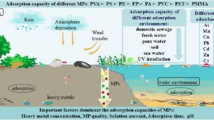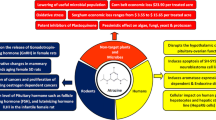Abstract
The herbicide 2,4-dichlorophenoxyacetic acid (2,4-D) is among the most frequently detected pesticides in the water-column of surface waters in Canada. Bottom sediments (0 to 15 cm) were collected in 41 wetlands across the prairie region of Canada and analyzed for organic carbon content (OC), pH, and texture. Using batch equilibrium experiments at 5 and 25°C, the herbicide sorption coefficient, Kd, was determined for 41 sediments, along with more comprehensive herbicide sorption and desorption isotherms for 7 of these 41 sediments. The 2,4-D Kd was positively correlated with OC and negatively correlated with sediment pH. A small (3%) significant increase in the 2,4-D Kd occurred when the temperature was at 25°C rather than 5°C. Desorption rates were faster for sediments with ≤ 2.4% OC and exhibited little or no hysteresis, compared to sediments with ≥ 5.9% OC that consistently exhibited hysteresis. We conclude that bottom sediments could serve as a source of 2,4-D to the water-column regardless of water temperature (5 to 25°C). However, the potential for accumulation of 2,4-D in wetland sediments would be small because between 62 and 100% of the 2,4-D sorbed by sediments was released after 8 hours.
Similar content being viewed by others
Literature Cited
Aksu, Z. and E. Kabasakal. 2005. Adsorption characteristics of 2,4-dichlorophenoxyacetic acid (2,4-D) from aqueous solution on powdered activated carbon. Journal of Environmental Science and Health, Part B 40: 545–70.
Alam, J. B., A. K. Dikshit, and M. Bandyophadyay. 2002. Effect of different inorganic and organic compounds on sorption of 2,4-D and atrazine. Journal of Environmental Science and Health, Part B 37: 541–60.
Bekbölet, M., O. Yenigün, and I. Yücel. 1999. Sorption studies of 2,4-D on selected soils. Water Air and Soil Pollution 111: 75–88.
Bowman, B. T. 1981. Anomalies in the log Freundlich equation resulting in deviations in adsorption K values of pesticides and other organic compounds when the system of units is changed. Journal of Environmental Science and Health, Part B 16: 113–23.
Bowman, B. T. 1982. Conversion of Freundlich adsorption K values to the mole fraction format and the use of SY values to express relative adsorption of pesticides. Soil Science Society of America Journal 46: 740–43.
Calvet, R. 1989. Adsorption of organic chemicals in soils. Environmental Health Perspectives 83: 145–77.
Celis, R., M. C. Hermosin, L. Cox, and J. Cornejo. 1999. Sorption of 2,4-dicholorphenoxyacetic acid by model particles simulating naturally occurring soil colloids. Environmental Science and Technology 33: 1200–06.
Cessna, A. J. and J. A. Elliot. 2004. Seasonal variation of herbicide concentrations in prairie farm dugouts. Journal of Environmental Quality 33: 302–15.
Cowardin, L. M., V. Carter, F. C. Golet, and E. T. LaRoe. 1979. Classification of Wetlands and Deepwater Habitats of the United States. U.S. Department of the Interior, Fish and Wildlife Service, Washington, DC, USA.
Donald, D. B., A. J. Cessna, E. Sverko, and N. E. Glozier. 2007. Pesticides in surface drinking-water supplies of the northern Great Plains. Environmental Health Perspectives 115: 1183–91.
Donald, D., N. Gurprasad, L. Quinnett-Abbott, and K. Cash. 2001. Diffuse geographic distribution of herbicides in northern prairie wetlands. Environmental Toxicology and Chemistry 20: 273–79.
Donald, D. B. and J. Syrgiannis. 1995. Occurrence of pesticides in prairie lakes in Saskatchewan in relation to drought and salinity. Journal of Environmental Quality 24: 266–70.
Donald, D. B., J. Syrgiannis, F. Hunter, and G. Weiss. 1999. Agricultural pesticides threaten the ecological integrity of northern prairie wetlands. Science of the Total Environment 231: 173–81.
Gaultier, J., A. Farenhorst, and G. Crow. 2006. Spatial variability of soil properties and 2,4-D sorption in a hummocky field as affected by landscape position and soil depth. Canadian Journal of Soil Science 86: 89–95.
Gaultier, J., A. Farenhorst, J. Cathcart, and T. Goddard, T. 2008. Regional assessment of herbicide sorption and degradation in two sampling years. Journal of Environmental Quality 37: 1825–36.
Gee, G. W. and J. W. Bauder. 1986. Particle-size analysis. p. 383–412.In A. Klute (ed.) Methods of Soil Analysis. Part 1. Physical and Mineralogical Methods. ASA/SSSA, Madison, WI, USA.
Grover, R., S. R. Shewchuk, A. J. Cessna, A. E. Smith, and J. H. Hunter. 1985. Fate of 2,4-D iso-octyl ester application to a wheat field. Journal of Environmental Quality 14: 203–10.
Grover, R., D. T. Waite, A. J. Cessna, W. Nicholaichuk, and D. G. Irvin. 1997. Magnitude and persistence of herbicide residues in farm dugouts and ponds in the Canadian prairies. Environmental Toxicology and Chemistry 16: 638–43.
Gupta, V. K., I. A. Suhas, and V. K. Saini. 2006. Adsorption of 2,4-D and carbofuran pesticides using fertilizer and steel industry wastes. Journal of Colloid and Interface Science 299: 556–63.
Haberhauer, G., L. Pheiffer, and M. H. Gerzabek. 2000. Influence of molecular structure on sorption of phenoxyalkanoic herbicides on soil and its particle size fractions. Journal of Agriculture and Food Chemistry 48: 3722–27.
Hermosin, M. C. and J. Cornejo. 1993. Organic chemicals in the environment:binding mechanism of 2,4-dichlorophenoxyacetic acid by organo-clays. Journal of Environmental quality 22: 325–31.
LaBaugh, J. W., T. C. Winter, G. A. Swanson, D. O. Rosenberry, R. D. Nelson, and N. H. Euliss. 1996. Changes in atmospheric circulation patterns affect mid-continent wetlands sensitive to climate. Limnology and Oceanography 41: 864–70.
Larney, F. J., A. J. Cessna, and M. S. Bullock. 1999. Herbicide transport on wind-eroded sediment. Journal of Environmental Quality 28: 1412–21.
Legendre, P. and L. Legendre. 1998. Numerical Ecology, 2nd edition. Elsevier, Amsterdam, The Netherlands.
Lorah, M. M. and M. A. Voytek. 2004. Degradation of 1,1,2,2-tetrachloroethane and accumulation of vinyl chloride in wetland sediment microcosms and in situ porewater: biogeochemical controls and associations with microbial communities. Journal of Contaminant Hydrology 70: 117–49.
Mallawatantri, A. P. and D. J. Mulla. 1992. Herbicide adsorption and organic carbon contents on adjacent low-input versus conventional farms. Journal of Environmental Quality 21: 546–51.
Ma, L., L. M. Southwick, G. H. Willis, and H. M. Selim. 1993. Hysteretic characteristics of atrazine adsorption-desorption by a Sharkey soil. Weed Science 41: 627–33.
McKeague, J. A. 1978. Manual on Soil Sampling and Methods of Analysis. Canadian Society of Soil Science, Ottawa, ON, Canada.
Nelson, D. E. and L. E. Sommers. 1982. Total carbon, organic carbon, and organic matter. p. 539–577.In A. L. Page (ed.) Methods of Soil Analysis. Part 2. Chemical and Microbiological Properties. ASA/SSSA, Madison, WI, USA.
Picton, P. and A. Farenhorst. 2004. Factors influencing 2,4-D sorption and mineralization in soil. Journal of Environmental Science and Health, Part B 39: 367–79.
Rawn, D. F. K., T. H. J. Halldorson, B. D. Lawson, and D. C. G. Muir. 1999. A multi-year study of four herbicides in air and precipitation from a small prairie watershed. Journal of Environmental Quality 28: 898–906.
Sannino, F., M. T. Filazzola, A. Violante, and L. Gianfreda. 1999. Fate of herbicides influences by biotic and abiotic interactions. Chemosphere 39: 333–41.
Senseman, S. A. 2007. Herbicide Handbook, 9th edition. Weed Science Society of America, Lawrence, KS, USA.
Seybold, C. A., W. Mersie, J. Huang, and C. McNamee. 2002. Soil redox, pH, temperature, and water-table patterns of a freshwater tidal wetland. Wetlands 22: 149–58.
Seybold, C. A., W. Mersie, C. McName, and D. Tierney. 1999. Release of Atrazine [14C] from two undisturbed submerged sediments over a two-year period. Journal of Agriculture and Food Chemistry 47: 2156–62.
Smith, G. W. 1995. A Critical Review of the Aerial and Ground Surveys of Breeding Waterfowl in North America. U.S. Department of the Interior, National Biological Service, Biological Science Report 5, Springfield, VA, USA.
Spadotto, C. A. and A. G. Hornsby. 2003. Soil sorption of acidic pesticides. Modeling pH effects. Journal of Environmental Quality 32: 745–50.
Sparks, D. L. 1989. Kinetics of Soil Chemical Processes. Academic Press, San Diego, CA, USA.
Ten Hulscher, T. E. M. and G. Cornelissen. 1996. Effect of temperature on sorption equilibrium and sorption kinetics of organic micropollutants — a review. Chemosphere 32: 609–26.
van Genuchten, M. T., J. M. Davidson, and P. J. Wierenga. 1974. An evaluation of kinetic and equilibrium equations for the prediction of pesticide movement through porous media. Soil Science Society of America Proceedings 38: 29–35.
Waite, D. T., A. J. Cessna, R. Grover, L. A. Kerr, and A. D. Snihura. 2002. Environmental concentrations of agricultural herbicides: 2,4-D and triallate. Journal of Environmental Quality 31: 129–44.
Warner, B. G. and C. D. A. Rubec. 1997. The Canadian Wetland Classification System. National Wetlands Working Group, Wetlands Research Centre, University of Waterloo, Waterloo, ON, Canada.
Author information
Authors and Affiliations
Rights and permissions
About this article
Cite this article
Gaultier, J., Farenhorst, A., Kim, S.M. et al. Sorption-desorption of 2,4-dichlorophenoxyacetic acid by wetland sediments. Wetlands 29, 837–844 (2009). https://doi.org/10.1672/08-42.1
Received:
Accepted:
Issue Date:
DOI: https://doi.org/10.1672/08-42.1




